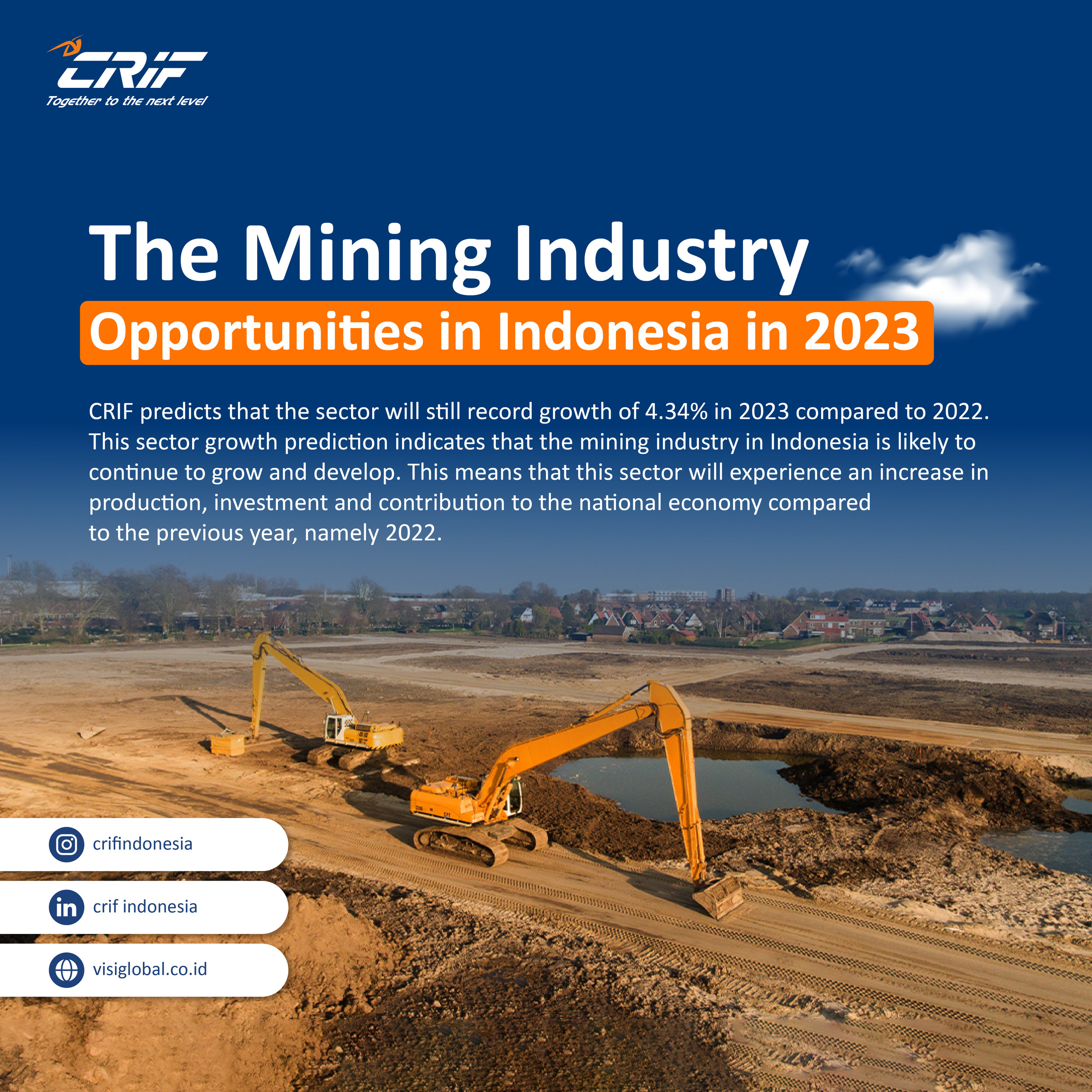The mining industry in Indonesia has played a very important role in the country's economy over the past few decades. Known as one of the largest mineral and coal producers in the world, Indonesia has abundant mining potential covering a variety of valuable commodities, from nickel to gold.
The mining industry in Indonesia has played a very important role in the country's economy over the past few decades. Known as one of the largest mineral and coal producers in the world, Indonesia has abundant mining potential covering a variety of valuable commodities, from nickel to gold.
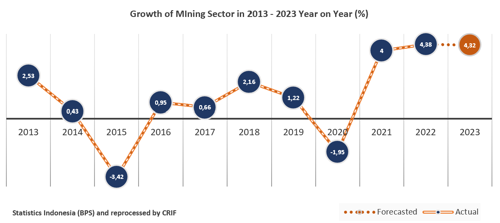
CRIF predicts that the sector will still record growth of 4.34% in 2023 compared to 2022. This sector growth prediction indicates that the mining industry in Indonesia is likely to continue to grow and develop. This means that this sector will experience an increase in production, investment and contribution to the national economy compared to the previous year, namely 2022. Factors such as global demand for mining commodities and government efforts to improve regulations and support investment can be the main drivers of the growth. This prediction provides a positive view regarding the prospects for the mining sector in the coming year.
Based on the article entitled "Outlook 2023: Sektor Pertambangan Diproyeksi Masih Jadi Andalan" (Outlook 2023: Mining Sector Projected to Still Be a Mainstay) published by IDX Channel on January 5, 2023, the mining sector is predicted to still be the mainstay of the Indonesian economy in 2023. This growth will be supported by the growth of the coal subsector (6.4%), oil and natural gas (4.8%), and metallic minerals (3.2%). This is supported by several factors, among others:
· Demand for mineral and coal commodities is still high from various countries, especially for industrial and energy purposes.
· Indonesia has large and diverse mineral and coal reserves.
· The Indonesian government continues to encourage the development of the mining sector, both in terms of downstream and regulatory aspects.
Mining Sector Contribution to National GDP
In Q2/2023, the mining sector made a significant contribution to the national Gross Domestic Product (GDP), reaching 10.48%. However, in Q2, the share of this sector decreased by 8.83% compared to the previous quarter (QoQ) to IDR 547,856.9 billion. Although this percentage may still be below important sectors such as manufacturing and agriculture, the mining sector still exceeds the contribution of several other industries. In particular, the mining sector outperformed sectors such as information and communications, with a contribution of IDR 220,049.1 billion (4.21%), financial services and insurance of IDR 214,372.9 billion (4.10%), transportation and warehouse with value of IDR 306,656.1 billion (5.87%), water supply and waste management with a contribution of IDR 3,343.3 billion (0.06%), electricity and gas of IDR 53,226.2 billion (1.02%), and services health and social activities which contributed IDR 62,634.8 billion (1.20%) (BPS, 2023).
In Indonesia, the mining sector is divided into 4 business groups, namely Oil, Gas and Geothermal Mining, Coal and Lignite Mining, Metal Ore Mining, and Mining and Other Extraction.
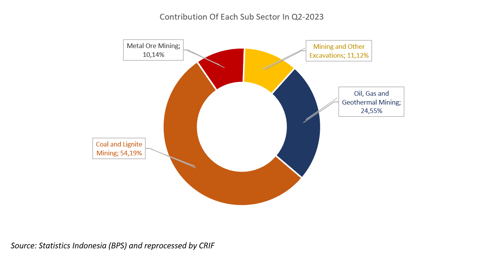
Based on the contribution diagram of the mining sub-sector to the total contribution of the mining sector in Indonesia, it can be concluded that the "Coal and Lignite Mining" sub-sector dominates with a contribution percentage reaching 54.19%. This shows that coal and lignite are still the main commodities in the Indonesian mining industry. Furthermore, the "Oil, Gas and Geothermal Mining" sub-sector accounts for around 24.55%, indicating the importance of the energy sector in the country's mining structure. Meanwhile, the "Metal Ore Mining" and "Mining and Other Extraction" sub-sectors had smaller contributions of around 10.14% and 11.12% respectively. This conclusion illustrates the relative distribution of various sub-sectors within the Indonesian mining sector.
Development of Mining Commodity Exports in January-June 2022 and 2023
Exports of mining commodities are an important aspect of the economy of a country that has abundant natural resources. January to June 2022 and 2023 is an interesting period to see how the Indonesian mining sector develops in terms of commodity exports.
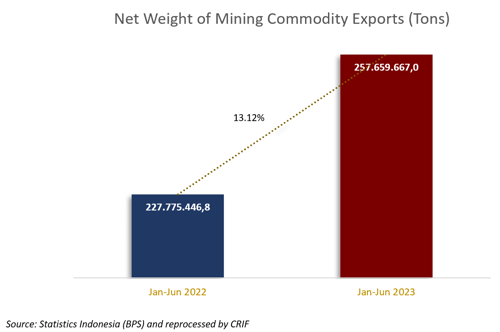
Exports of coal and crude oil became the backbone of mining commodity exports during this period. Despite price challenges, global demand for Indonesian coal continues to be strong. Meanwhile, crude oil also remains in demand by global markets.
In 2023, the Indonesian mining sector shows positive signs of recovery in commodity exports. Factors such as global economic recovery and commodity price stability have provided positive impetus. Coal exports remain the main contributor to this sector. Demand from countries such as China and Singapore remains high, and innovations in logistics and shipping have helped increase the competitiveness of Indonesian coal in international markets.
Potential Growth in Mining Mineral Exploration
Apart from that, exploration and exploitation of mining minerals, such as nickel, copper and tin, is also starting to show growth potential. Demand for raw materials for the technology and electric vehicle (EV) industries has helped boost exports of certain minerals.
Based on the article entitled "Kadin Ungkap Sektor Pertambangan RI Dinilai Masih Menarik, Ini Alasannya" (Kadin Reveals the Indonesian Mining Sector is Still Considered Attractive, Here's the Reason) published by IDX Channel on July 20, 2023, the mining sector in Indonesia is still considered attractive for investment. This is supported by several factors, among others:
· The potential for large and varied mineral and coal reserves.
· The high demand for mineral and coal commodities from various countries, especially for industrial and energy purposes.
· The Indonesian government continues to encourage the development of the mining sector, both in terms of regulation and investment.
Based on data from the Ministry of Energy and Mineral Resources (ESDM), Indonesia has quite large mineral and coal reserves, namely 2.3 billion tons of nickel, 1.7 billion tons of bauxite, 1.1 billion tons of copper, 1.1 billion tons of coal, and 780 million tons of petroleum. These mineral and coal reserves make Indonesia one of the countries with the largest mineral and coal reserves in the world.
Demand for mineral and coal commodities is also still high from various countries, especially for industrial and energy purposes. Demand for mineral and coal commodities is expected to continue to increase along with global economic growth.
The Indonesian government also continues to encourage the development of the mining sector, both in terms of regulation and investment. The government has issued a number of regulations that support the development of the mining sector, such as Law Number 3 of 2020 concerning Minerals and Coal and Government Regulation Number 15 of 2022 concerning Mineral and Coal Mining. The government has also launched a number of programs to attract investment in the mining sector, such as the Indonesia Mining Week (IMW) program and the Mining Product Export Incentive (IEPP).
With these various factors, the mining sector in Indonesia is still considered attractive for investment. The mining sector can be a source of foreign exchange and employment for Indonesia. However, challenges such as increasing environmental regulations and sustainability remain relevant. The Indonesian government and relevant stakeholders need to collaborate to ensure that sustainable mining is the main focus for the long term.
Nickel prospects in the future
This commodity is an important raw material for making batteries in the electric vehicle (EV) industry, whose industry is growing exponentially.
According to a report by the United States Geological Survey (USGS), world nickel production is estimated to reach 3.3 million metric tons in 2022. This number is an increase of 20.88% compared to 2021 which was 2.73 million metric tons. Indonesia is the largest nickel producer in the world in 2022. Total production is estimated to reach 1.6 million metric tons or contribute 48.48% of total global nickel production in 2021.
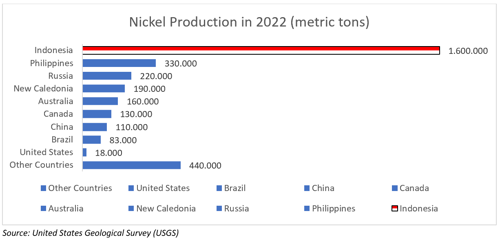
According to data from Statistics Indonesia (BPS), throughout 2022 Indonesia exported 777.4 thousand tons of nickel, an increase of 367% compared to the previous year (year-on-year/yoy). The total value of Indonesia's nickel exports in 2022 also jumped 369% (yoy) to USD 5.97 billion. These figures are the highest records in the last decade.
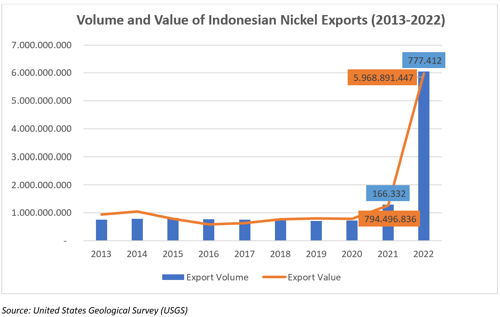
Throughout 2022, Indonesia exported the most nickel to China, with shipments of 661.7 thousand tons. The next largest buyers are Japan, South Korea, Malaysia, Norway, India, Singapore, Hong Kong, Belgium and Timor Leste.
The Indonesian government has banned the export of raw nickel ore since January 1, 2020. Since then, only nickel that has been processed has been allowed to be exported, making the price more expensive. Not only does it increase trade, the ban on exports of raw nickel ore also invites the flow of foreign investment into the nickel processing sector in Indonesia.
Challenges Faced by the Mining Industry
Despite having great potential in terms of natural resources, strict regulations, global environmental changes and societal demands for sustainability are increasingly challenging mining companies. Some of the main challenges faced by the Indonesian mining industry this year include:
1. Strict Environmental Regulations
The Indonesian government is increasingly tightening environmental regulations to reduce the negative impact of the mining industry on nature and society. Mining companies must now adhere to higher standards in waste management, rehabilitation of mined land and emissions control.
2. Technology and Innovation
Indonesia's mining industry needs to invest in technology and innovation to improve operational efficiency and reduce environmental impact. The application of automation, data analytics, and artificial intelligence (AI) is becoming increasingly important.
3. CSR and Relations with the Community
The importance of corporate social responsibility (CSR) is increasing. Conflicts with local communities can damage a company's reputation and hinder mining projects. Building strong relationships with local communities and practicing sustainable CSR is the key.
4. Availability of Skilled Human Resources
The mining industry often struggles to find the skilled workforce needed to operate sophisticated equipment and comply with safety standards. Workforce training and development is important.
5. Volatile Commodity Prices
Depending on the commodities they produce, mining companies can feel the impact of global price fluctuations. Global economic and geopolitical uncertainty can cause price volatility, which can impact investment plans, expansion and sustainability of mining operations.
6. Access to Capital and Investment
Large investments are required for mine expansion and development. Attracting investors and gaining access to necessary capital has become increasingly important, especially amidst global economic uncertainty.
As we face a challenging year 2023, the Indonesian mining industry needs to focus on innovation, sustainability and social responsibility to remain competitive in the global market and provide benefits to the country and society. Transforming towards a more sustainable mining industry is key to overcoming challenges and exploiting existing opportunities.
